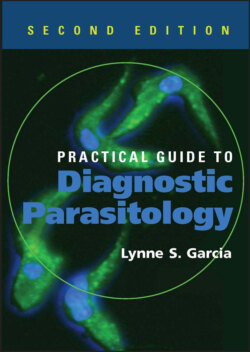Читать книгу Practical Guide to Diagnostic Parasitology - Lynne Shore Garcia - Страница 79
На сайте Литреса книга снята с продажи.
Specimen Type, Stability, and Need for Preservation
ОглавлениеFresh specimens are required for the recovery of motile trophozoites (amebae, flagellates, or ciliates). The protozoan trophozoite stage is found in patients with diarrhea; the gastrointestinal tract contents are moving through the system too rapidly for cyst formation to occur. Once the stool specimen is passed from the body, trophozoites do not encyst but may disintegrate if not examined or preserved within a short time after passage. However, most helminth eggs and larvae, coccidian oocysts, and microsporidian spores can survive for extended periods. Since it is impossible to know which organisms might be present, it is recommended that the most conservative time limits be used for parasite preservation and recovery. Liquid specimens should be examined within 30 min of passage, not 30 min from the time they reach the laboratory. If this general time recommendation of 30 min is not possible, the specimen should be placed in one of the available fixatives. Soft (semiformed) specimens may contain a mixture of protozoan trophozoites and cysts and should be examined within 1 h of passage; again, if this time frame is not possible, preservatives should be used. Immediate examination of formed specimens is not as critical; in fact, if the specimen is examined any time within 24 h after passage, the protozoan cysts should still be intact (Table 3.3).
Currently, fresh or frozen fecal specimens are required for the following fecal immunoassays (either as a single-organism test or when combined with other organisms such as G. lamblia or Cryptosporidium spp.): E. histolytica/E. dispar group and E. histolytica.
Summary: Collection of Fresh Stool Specimens
1. Occupational Safety and Health Act regulations (Standard Precautions) should be used for handling all specimens.
2. Interfering substances (e.g., barium, mineral oil, or antibiotics) should be avoided when stool specimens are collected.
3. Contamination with urine or water should be avoided.
4. Recommendation for collection: two (minimum) or three specimens collected, one every other day or within a 10-day time frame; see Table 3.1 for options and pros/cons.
5. Liquid stool should be examined or preserved within 30 min of passage (trophozoites). Soft stool should be examined or preserved within 1 h of passage (trophozoites and cysts*). Formed stool should be examined or preserved within 24 h of passage.
6. Fresh or frozen fecal specimens are required for the following fecal immunoassays (either as a single-organism test or combined with other organisms such as G. lamblia or Cryptosporidium spp.): E. histolytica/E. dispar group and E. histolytica. Fresh, frozen, or preserved specimens can be used for G. lamblia and Cryptosporidium spp.; specimens submitted in Cary-Blair transport medium are also acceptable. Note: Due to the freeze-thaw cycle, frozen specimens cannot be used for the FA procedures for G. lamblia and/or Cryptosporidium spp. (destruction of the actual cysts and/or oocysts that are visual proof of a positive specimen).
* Dientamoeba fragilis trophozoites can be found in formed stool specimens.
